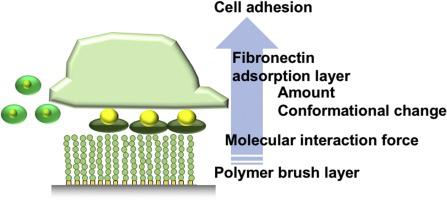Colloids and Surfaces B: Biointerfaces ( IF 5.8 ) Pub Date : 2020-06-17 , DOI: 10.1016/j.colsurfb.2020.111205 Kazuhiko Ishihara 1 , Katsuya Mitera 1 , Yuuki Inoue 1 , Kyoko Fukazawa 1

|
The effects of protein adsorption on the polymer brush surfaces with well-defined chemical structures and physical properties were examined with respect to initial protein adsorption, structural changes to the adsorbed proteins, and subsequent cell adhesion. Four polymer brush surfaces with different hydrophilicities and charge states were prepared. The molecular interaction forces during adsorption-desorption processes of protein on the polymer brush surfaces depending on the chemical structure of the polymer were determined. Crucially, these molecular interactions affected the adsorption behavior and structural changes of fibronectin (FN), a cell-adhesive protein, used in this study. Adsorption of FN onto the zwitterionic polymer and anionic polymer surfaces was difficult, however significant protein adsorption to the hydrophobic and cationic surfaces was observed. Further, the structural changes to the adhered FN on these surfaces were significant. Subsequent cell adhesion experiments revealed that the adhered cell density was correlated with the amount of adsorbed FN and the degree of FN structural change. In addition, the cationic surface inhibited cell proliferation behavior. These results indicate that cellular responses can be indirectly regulated by controlling the molecular interactions which induced the structural change of adsorbed proteins via the material surface properties.
中文翻译:

不同聚合物刷表面上的分子相互作用对纤连蛋白吸附诱导的细胞粘附的影响。
相对于初始蛋白质吸附,吸附蛋白质的结构变化以及随后的细胞粘附,研究了蛋白质吸附在具有明确定义的化学结构和物理性质的聚合物刷表面上的影响。制备了四个具有不同亲水性和电荷状态的聚合物刷表面。确定了蛋白质在聚合物刷表面上的吸附-解吸过程中的分子相互作用力,具体取决于聚合物的化学结构。至关重要的是,这些分子相互作用影响了本研究中使用的细胞粘附蛋白纤连蛋白(FN)的吸附行为和结构变化。FN在两性离子聚合物和阴离子聚合物表面上的吸附非常困难,然而,观察到显着的蛋白质吸附到疏水和阳离子表面上。此外,这些表面上粘附的FN的结构变化非常明显。随后的细胞粘附实验表明粘附的细胞密度与FN的吸附量和FN结构改变的程度有关。另外,阳离子表面抑制了细胞增殖行为。这些结果表明,可通过控制分子相互作用来间接调节细胞应答,所述分子相互作用通过材料表面性质诱导吸附的蛋白质的结构变化。随后的细胞粘附实验表明粘附的细胞密度与FN的吸附量和FN结构改变的程度有关。另外,阳离子表面抑制了细胞增殖行为。这些结果表明,可通过控制分子相互作用来间接调节细胞应答,所述分子相互作用通过材料表面性质诱导吸附的蛋白质的结构变化。随后的细胞粘附实验表明粘附的细胞密度与FN的吸附量和FN结构改变的程度有关。另外,阳离子表面抑制了细胞增殖行为。这些结果表明,可通过控制分子相互作用来间接调节细胞应答,所述分子相互作用通过材料表面性质诱导吸附的蛋白质的结构变化。



























 京公网安备 11010802027423号
京公网安备 11010802027423号